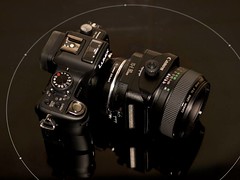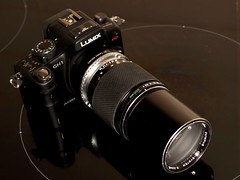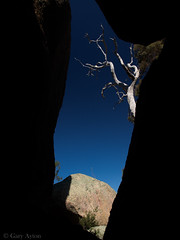Until recently if you wanted to do radio remote TTL flash, you needed a Canon dSLR with a Canon-compatible flash and a radio remote system, or a Nikon dSLR with a Nikon-compatible flash and a radio remote system.
Initially these radio remote systems were provided by companies such as PocketWizard or RadioPopper, and then a couple of years ago both Canon then Nikon added their own radio remote TTL flash to their latest cameras and flashes.
The PocketWizard system particularly became very popular with the professional photographers and is renown for its reliability, build quality and the early ground breaking ability to not only provide remote TTL flash and HSS flash and pas-through TTL to a top-mounted hotshoe but also its proprietary HyperSync which allowed full output flash at marginally faster than usual shutter speeds without the power output loss that HSS flash caused.
Unfortunately, Pocket Wizard failed to recognise the ground swell of mirrorless cameras and increasing cross-system ownership that has resulted and although they did create a remote system which supported the Panasonic GH4, in general their receivers would not fire Olympus flashes even in manual mode let alone TTL mode with Olympus cameras, and of course if you owned a couple of camera systems you had to have a different set of Pocket Wizard units (Flex TT5/TT6/MiniTT1) for each camera system, and there was, and still is, no mix and matching of systems in TTL mode.
But its now mid-2017, and we are in a totally new scene thanks to Cactus V6 II remote system and the Godox remote system – both of which offer cross-platform radio remote TTL flash albeit with different approaches.
If I were to buy a flash unit or studio flash now, I would strongly consider how it would be used for my Olympus, Sony and Canon cameras with either or both of the two new systems – neither of which are perfect but a vast improvement on what we currently have, and far better than the rubbish optical remote RC mode of the Olympus system (yes, I love Olympus but I am not paid by any company including Olympus who have never offered me any freebies or special discounts and so yes, I am able to call them out when I feel it is appropriate – that said perhaps they have done us all a big favour in allowing these new third party solutions to come to the party and solve our problems).
Let’s compare the two cross-platform approaches to radio remote TTL flash:
The Cactus V6 II approach:
This is the more cost effective approach, particularly if you have existing flash units – you just buy 1 transceiver to mount on the camera and another to mount on your digital-TTL capable flash (the flash will need to be either Canon, Nikon or Olympus digital TTL capable – not Pentax unless you are also using a Pentax camera, and not Fujifilm unless you are also using a Fujifilm camera).
These transceivers are able to AUTO-Detect the camera or flash system (although there are a few gotchas and workarounds – see later).
This means IF it all works as the manufacturer suggests it will, you could buy 5 units, place one on your Olympus camera’s hotshoe (which can optionally also mount any digital TTL flash unit as outlined above) and attach one to each of a Canon 580EXII flash, an Olympus FL50R flash, a Godox TT685 flash and a Nikon SB-900 flash and ALL will fire with radio remote TTL exposures with flash exposure compensation in 0.1EV increments and separate for each (if they are assigned to one of the 4 possible radio groups) and optionally in HSS/FP mode for faster shutter speeds and wider apertures, or one of the two Group Sequence modes, remote manual flash zoom, and even in the Cactus proprietary Power Sync mode which allows a slightly faster than usual shutter speed at full flash output – and yet there is much more it can do including display all flash unit power outputs, Delay mode, AF assist light and remote camera shutter release!
Decide to use your Canon dSLR to shoot instead, cool, just turn the transceiver off, put it on the Canon, let it auto-detect and away you go.
Working in an environment with lots of other photographers using the same system which is causing cross firing – no problem, just set all your transceivers to the same 4 digit RADIO ID value.
If you are running a workshop and want other users to fire your flash set up – no problem – just make sure they are using the same radio ID and turn on Multi-Master mode each photographer can choose their own exposure compensation settings – just try to avoid firing at the same time as someone else!
As an alternative, you can buy a very affordable Cactus RF60X flash unit which already has a remote transceiver built in so this saves you money and complexity.
Some gotchas and workarounds of the Cactus V6 II system:
- there is a special Sony version of the transceiver (V6 IIs) which is required if you wish to attach to either a Sony camera or a Sony-mount flash, but it can essentially achieve the same as the above.
- requires firmware upgrade for cross-platform compatibility, the Olympus/Panasonic/Micro Four Thirds compatibility should be available August 2017.
- as with the Godox system, it operates in the 2.4GHz radio frequency range and this may have issues with interference at times and is generally limited to 100m
- READ the MANUAL: to auto-detect camera system, half-press the shutter release of camera while switching on the V6 II to TX mode
- Power Sync may require the user to adjust the sync time in order to eliminate any banding issues (black line across the image).
- “Power Sync” may not give you much more and there is no option to go less than full power output – but then you usually want full power output in these situations unless you also need short recycle times.
- Cactus V6 II does not work with Cactus V4, V2s or V2 flash trigger models (but is compatible with V6 but not in HSS mode, and with V5 for basic non-TTL modes only including flash triggering and shutter release triggering)
- there is a limited range (currently 60 units) of currently available flash units that are automatically usable with this system – others will require you to create your own custom flash profile on your computer and upload it to the transceiver (this can store up to 10 such profiles) and then you will need to manually select which profile to use for the flash.
- some cameras have a thicker than usual metal spring plate in the hotshoe which can interfere with the flash contacts and this may need to be removed (easily done) – examples include some Olympus OM-D E-M1 and Fujifilm models – this does not appear to be a problem with my E-M1 mark I or mark II
- the hotshoe locking pin position is optimised for Canikon and thus there may be some mechanical instability on other systems, when using Olympus flashes, moving it 0.5mm may remedy this, but there may still be issues on the camera and this becomes more risky if you are mounting a flash onto the camera-mounted transceiver as the weight may cause it to fall off – this does not appear to be a problem with my E-M1 mark I or mark II
- the latest July firmware has issues with TTL passthrough when used with the Olympus E-M1 Mark II (mark I seems to be OK in brief testing)
- there is limited compatibility with some cameras including:
- Nikon D600 and Panasonic GX-8 camera are not fully compatible with HSS mode when used with a Cactus RF60 flash (but presumably the RF60X is OK)
- high-speed sync modes not supported on Fujifilm X-E2 / XE2S, Fujifilm X100T cameras, and, Fujifilm flashes do not support HSS capabilities.
The Godox X1 approach:
Godox have really taken massive strides towards world domination of enthusiast and pro lighting (and their sudden rise in popularity perhaps may be part of the reason for Bowens lighting company apparently going out of business – although the Bowens name will live on thanks to the Bowens S mount which is one of the more universal lighting accessory mounts – including for the Godox studio style lights).
In the first instance they brought to the market their lovely, powerful and versatile portable flash units with lithium ion batteries and battery packs which have made strobists all over the world jump for joy.
Next, they upped the ante substantially this year when they announced cross-platform support.
Unlike the Cactus system (other than the dedicated Cactus V6 II Sony module), the Godox remote transceivers require a system dedicated transceiver attached to the camera hotshoe such as:
- for Olympus or Panasonic cameras either:
- Godox X1T-O wireless flash trigger due August 2017 $US46
- Godox TT350-O flash unit
- Flashpoint Zoom Mini R2 TTL flash unit
- for Canon cameras, X1C TTL Wireless Flash Trigger
- for Nikon cameras, X1N TTL Wireless Flash Trigger
- for Sony cameras, the X1S TTL Wireless Flash Trigger
- for Fuji cameras, the X1T-F TTL Wireless Flash Trigger
Each of these camera mounted X1 triggers have a TTL-pass-through top hotshoe.
Like the Cactus system with their Cactus RX60X, there are Godox flash units with inbuilt receivers and a very nice range of units there are such as:
- Godox Wistro AD600 portable 600Ws lithium ion battery studio flash with ability to be used with either a 600Ws or incredible 1200Ws flash head (this requires two AD600’s to power it), and optional lithium ion battery pack and Bowens or Godox mount studio lighting accessories such as softboxes
- Godox Wistro AD360II – a more portable option but it is regarded as too heavy to mount on a camera, usually used with hand grip and power pack and strobists accessories
- Godox Wistro AD200 pocket flash
- Godox Wistro AR400 ring flash
- Godox V860II-O – similar to an Olympus FL-50R in that it can use the Olympus optical RC system as master or slave, but in addition it can be used as a slave (and perhaps as a master according to web page specs) for the Godox X1 system, and it uses a 2000mAh lithium ion battery pack for 650 full power shots per full battery charge
Unlike the Cactus system, if you wish to fire a non-Godox flash unit in remote TTL mode, you will need a different Receiver unit and specifically, one that matches the flash system, thus, for a Canon flash you will need the X1R-C receiver to attach the the Canon flash.
A brief side-by-side comparison:
| Cactus V6 II | Godox X1 |
|
| Price | $US95 per transceiver |
$US46 for transceiver |
| types of units needed | only 1 type BUT need a different one for a Sony camera or flash | need a different one for each camera system, and a different receiver for each system of non-Godox X1 flash, for example, a XTR-16, XTR-16S receiver |
| radio frequency | 2.4GHz, range up to 100m |
2.4GHz, range up to 100m |
| radio groups | 4 |
5 |
| radio channels | 16 | 32 |
| Radio ID | 4 digit |
No |
| HSS / FP mode | most cameras (except Fujifilm flashes) |
most cameras except Fujifilm? |
| front/rear curtain sync | Yes |
Yes |
| Multi-flash strobe mode | Yes |
Yes |
| flash exposure compensation | Yes, +/- 3EV in 0.1EV increments |
Yes, +/- 3EV in 1/3rd EV increments |
| remote manual zoom control | Yes |
Yes |
| AF assist lamp | Yes 1W LED |
Yes manual open |
| Multi-Master mode | Yes, up to 20 photographers |
? |
| Power sync mode | Yes but needs user to configure |
Can sync E-M1 to 1/320th in PC-Sync non-TTL mode |
| Flash delay mode | Yes 1msec to 999 secs |
0-10msec for synch delay adjustment |
| hotshoe locks into Olympus cameras to avoid slippage | Maybe (lock pin slightly out as optimised for Canikon) | Yes (X1T-O) |
| PC sync socket | Yes |
Yes |
| USB firmware upgradeable | Yes | Yes |
| Can remotely trigger camera shutter release via cable | Yes “Relay mode” – also available is a laser motion detection trigger to radio remotely act on the V6 II | ? |
| power supply | 2 x AA batteries | 2 x AA batteries |
| size | 72x72x42mm, 96g |
72x75x52mm, 90g |
| ease of use | must set to auto detect when starting, but otherwise fairly universal plug and play |
camera-dedicated transceivers do not need to auto detect |
| low power output for short flash exposures | 1/256th output |
1/128th output only? |
| lock flash exposures | Yes | ? |
| display power of each flash unit | Yes | displays exp. compensation or power output fraction only |
| compatible flash units | 60 plus ability to store 10 custom profiles which user can create, or Cactus V6 II specific units such as RF60X |
system-specific flashes for the receiver, or Godox X1 compatible flashes including Wistro studio flashes |
| flash system for TTL mode when mounted on the transceiver on camera | any compatible flash – should Auto-detect?? | no passthrough TTL – single pin hotshoe only |
Which system should you buy?
If you need to purchase new flash units, and in particular, the awesome units such as the Wistro AD600 or AD360II, then it makes sense to go with the Godox system as you just need the flash units and the system specific transmitter for each camera system you own.
If you already have a mix of flashes, or you wish to use the special features of the cactus system such as Power Sync, then the Cactus V6II transceivers would be the way to go, although you may be wise until Cactus finalises all their TTL firmware and it is found to work as advertised.
It would not be entirely crazy to have BOTH systems for different needs.
It does alter which flash units I would invest in though, and perhaps the 3rd party flashes may be the best approach although there is always a risk the camera manufacturers introduce incompatibilities, but it is likely that Cactus and Godox will be able to address these through firmware updates.
Many pros will stay with their tried and true Pocket Wizards which do use a different bandwidth and are system specific with no cross-platform TTL or HSS capabilities – and there is no Olympus version as yet – ah yes, I have been waiting nearly 10 long years for an Olympus version and still there is no word.










